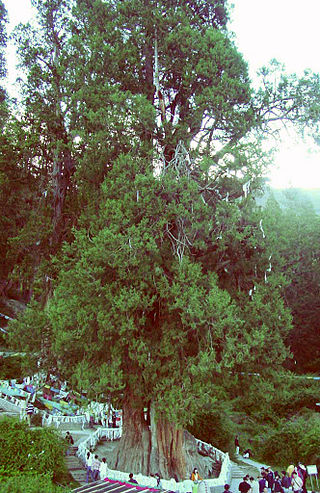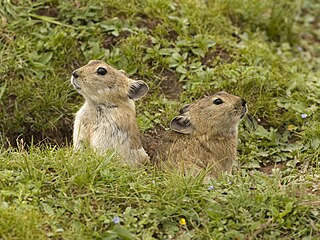
The Tibetan Plateau, also known as Qinghai–Tibet Plateau and Qing–Zang Plateau, is a vast elevated plateau located at the intersection of Central, South, and East Asia covering most of the Tibet Autonomous Region, most of Qinghai, western half of Sichuan, Southern Gansu provinces in Western China, southern Xinjiang, Bhutan, the Indian regions of Ladakh and Lahaul and Spiti as well as Gilgit-Baltistan in Pakistan, northwestern Nepal, eastern Tajikistan and southern Kyrgyzstan. It stretches approximately 1,000 kilometres (620 mi) north to south and 2,500 kilometres (1,600 mi) east to west. It is the world's highest and largest plateau above sea level, with an area of 2,500,000 square kilometres (970,000 sq mi). With an average elevation exceeding 4,500 metres (14,800 ft) and being surrounded by imposing mountain ranges that harbor the world's two highest summits, Mount Everest and K2, the Tibetan Plateau is often referred to as "the Roof of the World".

Eupetaurus is a genus of rodent in the family Sciuridae. Members of this genus are known as woolly flying squirrels. They are large to very large flying squirrels found in the highest rocky cliffs near the treeline of the Himalayas and Tibetan Plateau. Due to the inaccessibility of their montane habitat, they are difficult to study.

Hoh Xil or Kekexili, is an isolated region in the northeastern part of Qinghai-Tibet Plateau. On July 7, 2017, the Hoh Xil in Qinghai was listed among the UNESCO World Heritage Sites as "the largest and highest plateau in the world".

Cupressus gigantea, the Tibetan cypress, is a species of conifer in the family Cupressaceae in Asia. C. gigantea was previously classified as a subspecies of Cupressus torulosa because of their similar morphological characteristics and close distribution, but have since been genetically distinguished as separate species.

The Gansu mole is a species of mammal in the family Talpidae endemic to central China, where it occurs in Shaanxi, Gansu, Sichuan, and Qinghai. It is the only species in the genus Scapanulus.

The plateau pika, also known as the black-lipped pika, is a species of mammal in the pika family, Ochotonidae.
Streptomyces nanshensis is a bacterium species from the genus of Streptomyces which has been isolated from marine sediments from the South China Sea near the Nansha Islands in China.
Streptomyces rosealbus is a bacterium species from the genus of Streptomyces which has been isolated from forest soil from Yongsheng from the Yunnan Province in China.
Streptomyces xishensis is a bacterium species from the genus of Streptomyces which has been isolated from marine sediments from the South China Sea near the Xisha Islands in China.
Streptomyces zinciresistens is a filamentous bacterium species from the genus of Streptomyces which has been isolated from a copper and zinc mine in the Shaanxi province in China. Streptomyces zinciresistens is resistant against zinc.
Hymenobacter tibetensis is an UV-resistant bacterium from the genus Hymenobacter which has been isolated from the Qinghai-Tibet plateau in China.
Dyadobacter tibetensis is a Gram-negative, aerobic, rod-shaped and non-motile bacterium from the genus of Dyadobacter which has been isolated from a glacial ice core from the Tibetan Plateau in China.
Streptomyces lacrimifluminis is a bacterium species from the genus of Streptomyces which has been isolated from soil near the Tuotuo River from the Qinghai-Tibet Plateau from China. Streptomyces lacrimifluminis produces antibacterial compounds.
Streptomyces tremellae is a bacterium species from the genus of Streptomyces which has been isolated from the mushroom Tremella fuciformis from Gutian in China.
Streptomyces dengpaensis is a bacterium species from the genus of Streptomyces which has been isolated from desert soil from the Dengpa District in Tibet.
Streptomyces dangxiongensis is a bacterium species from the genus of Streptomyces which has been isolated from soil from the Qinghai-Tibet Plateau in China.
The Tibetan woolly flying squirrel is a species of very large flying squirrel in the genus Eupetaurus. It is found in the south-central portion of the Tibetan Plateau, namely south-central Tibet, northern Sikkim, and western Bhutan.

The Yunnan woolly flying squirrel is a species of very large flying squirrel in the genus Eupetaurus. It is found on the southeastern margin of the Himalayas, namely in northwestern Yunnan and potentially Myanmar.
Streptomyces apocyni is a bacterium species from the genus Streptomyces which has been isolated from the plant Apocynum venetum from Xinjiang in China.
Glaciihabitans tibetensis is a Gram-positive, aerobic, non-spore-forming and short-rod-shaped bacterium from the genus Glaciihabitans which has been isolated from ice water from the Midui Glacier in Tibet.






